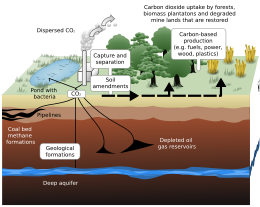
Carbon sequestration is the process of storing carbon in a carbon pool.[2]: 2248 It plays a crucial role in limiting climate change by reducing the amount of carbon dioxide in the atmosphere. There are two main types of carbon sequestration: biologic (also called biosequestration) and geologic.[3]
Biologic carbon sequestration is a naturally occurring process as part of the carbon cycle. Humans can enhance it through deliberate actions and use of technology. Carbon dioxide (CO
2) is naturally captured from the atmosphere through biological, chemical, and physical processes. These processes can be accelerated for example through changes in land use and agricultural practices, called carbon farming. Artificial processes have also been devised to produce similar effects. This approach is called carbon capture and storage. It involves using technology to capture and sequester (store) CO
2 that is produced from human activities underground or under the sea bed.
Plants, such as forests and kelp beds, absorb carbon dioxide from the air as they grow, and bind it into biomass. However, these biological stores may be temporary carbon sinks, as long-term sequestration cannot be guaranteed. Wildfires, disease, economic pressures, and changing political priorities may release the sequestered carbon back into the atmosphere.[4]
Carbon dioxide that has been removed from the atmosphere can also be stored in the Earth's crust by injecting it underground, or in the form of insoluble carbonate salts. The latter process is called mineral sequestration. These methods are considered non-volatile because they not only remove carbon dioxide from the atmosphere but also sequester it indefinitely. This means the carbon is "locked away" for thousands to millions of years.
To enhance carbon sequestration processes in oceans the following chemical or physical technologies have been proposed: ocean fertilization, artificial upwelling, basalt storage, mineralization and deep-sea sediments, and adding bases to neutralize acids.[5] However, none have achieved large scale application so far. Large-scale seaweed farming on the other hand is a biological process and could sequester significant amounts of carbon.[6] The potential growth of seaweed for carbon farming would see the harvested seaweed transported to the deep ocean for long-term burial.[7] The IPCC Special Report on the Ocean and Cryosphere in a Changing Climate recommends "further research attention" on seaweed farming as a mitigation tactic.[8]
- ^ "CCS Explained". UKCCSRC. Archived from the original on June 28, 2020. Retrieved June 27, 2020.
- ^ IPCC (2021). Masson-Delmotte, V.; Zhai, P.; Pirani, A.; Connors, S. L.; et al. (eds.). Climate Change 2021: The Physical Science Basis (PDF). Contribution of Working Group I to the Sixth Assessment Report of the Intergovernmental Panel on Climate Change. Cambridge University Press (In Press). Archived (PDF) from the original on June 5, 2022. Retrieved June 3, 2022.
- ^ Cite error: The named reference
:8was invoked but never defined (see the help page). - ^ Myles, Allen (September 2020). "The Oxford Principles for Net Zero Aligned Carbon Offsetting" (PDF). Archived (PDF) from the original on October 2, 2020. Retrieved December 10, 2021.
- ^ Renforth, Phil; Henderson, Gideon (June 15, 2017). "Assessing ocean alkalinity for carbon sequestration". Reviews of Geophysics. 55 (3): 636–674. Bibcode:2017RvGeo..55..636R. doi:10.1002/2016RG000533. S2CID 53985208. Retrieved March 3, 2024.
- ^ Cite error: The named reference
:152was invoked but never defined (see the help page). - ^ Cite error: The named reference
:73was invoked but never defined (see the help page). - ^ Cite error: The named reference
:242was invoked but never defined (see the help page).